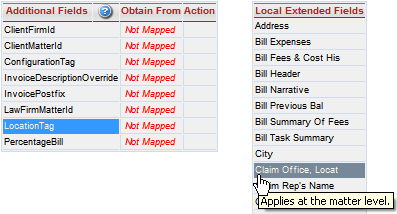|
Most law firms only configure one profile in eBillingHub. If this is true for your law firm, you'll only need to set up the default profile as explained in Configuring Your Law Firm Profile.
However, some firms may want to configure a separate profile for each of the firm's locations. For example, a firm may have its main office in New York and two branch offices in Philadelphia and Boston. To support these separate locations, you can configure the default profile for the New York office, and alternate profiles for the Philadelphia and Boston locations.
|
.png)
|
If desired, you can also configure alternate logon credentials when logging into a vendor site using an alternate profile. Click here for instructions.
|
When you configure an alternate law firm location profile, you specify a code of your choice for the new configuration. For example, the code could be an office or city name. To trigger eBillingHub to use this alternate configuration, you put the same code in a matter-level user defined field (UDF) in your Time and Billing system. You then map the client extended field called LocationTag to this UDF for each client whose invoices you want to process using the alternate location profile. If the value in the UDF matches the code that's specified for that profile, eBillingHub will use the alternate location profile when processing invoices for those clients.
To configure alternate law firm location profiles, follow these steps:
1. Select Configure the eBillingHub from the Configuration menu.
2. Click the Law Firm Profile option from the Configure Profiles tab to display the Law Firm Profile screen.
|

|
You must first create the default law firm profile before setting up alternate profiles. The default profile is normally created during the initial eBillingHub implementation.
|
3. Select Add New from the Location list box.

This action displays the following pop-up box:

4. Enter a code for the new profile configuration, and then click Ok. (This same code must be populated in a matter-level UDF to trigger eBillingHub to use the alternate profile as explained below.)
|
.png)
|
If you intend to create alternate logon credentials for this location, consider using the same code for both the alternate logon credentials and the alternate law firm profile.
|
5. Enter the alternate law firm profile information. (Data fields marked with a red asterisk are mandatory.) The following table lists the profile form fields:
|
Form Field
|
Description
|
|
*Firm Name:
|
The name of your law firm as it appears on invoices
|
|
*Tax ID:
|
A unique number that identifies your law firm's company for tax purposes
Note: eBillingHub uses the Tax ID as the default for the Law Firm Id. If an eBilling vendor's site uses the Tax Id to identify the law firm, it should match how it is entered here, including any dashes.
|
|
*Address:
|
The street or P.O. Box, city, state, zip code and country
|
|
*Email:
|
The firm's email address
|
|
*Phone:
|
The phone number used to contact the firm (toll-free number or toll line)
|
|
Fax:
|
The law firm's fax number
|
|
*First Name:
|
The first name of a contact at the law firm who handles eBilling
|
|
*Last Name:
|
The last name of the contact whose first name appears in the First Name field
|
|
Timekeeper ID:
|
The contact's timekeeper identification number, which is an alphanumeric Id or the contact's initials depending on the format in your firm's Time and Billing system
|
|
*Phone:
|
The phone number for the specified contact
|
|
*Email:
|
The email address of the specified contact
|
|
Fax:
|
The fax number for the specified contact
|
6. Click Submit to save the new law firm profile.
7. Repeat Steps 3 through 6 for each law firm profile you want to configure. Be sure to enter a unique code in Step 4 for each profile.
To create the extended field mapping to support the alternate law firm profile, follow these steps:
1. Designate a matter-level User Defined Field (UDF) in your law firm's Time and Billing system that will be used to trigger the alternate law firm profile when eBillingHub extracts invoice data.
2. Access the eBillingHub Map Client Extended Fields screen.
3. Select a client whose invoices you want to submit using the alternate law firm profile you created.
4. Select the LocationTag extended field in the Additional Fields column.
|

|
Not all eBillingHub supported client formats have the LocationTag extended field. If you require an alternate law firm profile for a client that does not have this field, contact eBillingHub Customer Support for assistance.
|
5. Select the UDF in the Local Extended Fields column that you have designated for the alternate law firm profile trigger. This action maps the selected UDF to the LocationTag extended field.

6. Click Save to save the mapping.
7. Repeat steps 3 through 6 for any additional clients whose invoices you want to submit using the alternate law firm profile.
If the value in the UDF you mapped to LocationTag is an exact match to the code you entered for the new configuration, eBillingHub will use the alternate law firm profile when processing the client's invoices.
Related Topics
.png) Configuring Alternate Logon Credentials Configuring Alternate Logon Credentials
.png) Mapping Client Extended Fields Mapping Client Extended Fields
|